CLINTON — This time of year, the big stars are Santa Claus and Rudolph.
Students in the Clinton Elementary School Lego Team couldn’t agree more, which is why the group of roughly 10 students have spent their afternoons building a motorized version of the Christmas duo with the toy building bricks Legos.
While the program provides students the opportunity to build and create with their classmates, the lessons behind the after-school club evoke a commitment to STEM — science, technology, engineering and mathematics.
The need for more knowledge and skill in those subjects is immense, as one in seven new jobs in Maine in the next 10 years is expected to be in STEM-related areas, according to a report by the Educational Development Center, a non-profit organization that researches how to improve education and workforce preparation.
Those STEM jobs will also yield wages that are 58 percent higher than other jobs in Maine, with an average annual wage of more than $55,000, according to the center, which was commissioned by the Maine Department of Labor.
There are more than three STEM jobs available for every one unemployed person, and there are three unemployed people for every one non-STEM job, with the demand growing for STEM employees nationally by 22 percent over the next four years, according to the Maine Department of Labor.
The work with Legos goes beyond just following directions and building something stationary — gone are the traditional square-and rectangular-shaped colored squares that snap into place. The Lego Team works with a set called Lego NXT, which combines the construction required traditional Legos with 21st-century technology. A Lego NXT set comes with a variety of different pieces, including gears and motors that can complete dozens of different projects.
In addition to following the correct steps to make individual blocks turn into Santa and Rudolph, the group is also required to program different motors and calibrate sensors, making the Lego set interactive.
With the hour was running down on the Lego Team’s weekly meeting, the group of students were hustling to get Santa, his sleigh and Rudolph finished. Determined to finish the project well before Wednesday’s Christmas festivities, the group split into two — one working on Rudolph, the other on Santa and the sleigh.
While most of the students continued to build, sixth-grader Bryce Dostie sat down at the computer, committed to making the structure functional.
“I love to build this stuff,” Dostie said, adding that he just got interested in programming in fifth grade, but has been building with Legos for a while. “I like computer stuff and I’m good at it. It’s one of my favorite things to do and I just combined my skill of programming with building.”
Dostie, who also enjoys hockey, soccer and baseball, worked diligently at the computer, making sure the Santa and Rudolph would work properly. When finished and turned on, Santa will pull on the reins as Rudolph runs and throws his head back as if they just jumped off a rooftop. When it’s turned on, Rudolph’s nose lights up bright red.
“We’ll connect that to the motor and to the reindeer,” Dostie said, pointing to a black electrical wire that doubled as Rudolph’s leash. “When we turn it on, it’ll make it look like they’re flying.”
Elementary schools such as Clinton’s have been working on developing STEM disciplines to engage its students, whether it’s using exciting technology like iPads and other tablets to captivate them or by disguising STEM lessons in with things children like to do, like play with Legos.
“I looked into the Lego NXT sets and saw how they were a good beginner STEM project,” said Sky Vargas, Clinton’s elementary school technology teacher.
Vargas, in her third year at the school, has established two after-school programs to help young students appreciate STEM activities. In addition to the Lego Team, which is in its first year as an after school program, Vargas oversees the Technology Team, a bi-weekly group that helps update computers, restock printers and set up overhead projectors throughout the school.
“The students end up helping teachers throughout the school with technological problems,” Vargas said.
Just like the Technology Team, the Lego Team consists of fourth, fifth and sixth graders from the kindergarten through sixth grade school. Vargas, who’s also the technology teacher at Albion Elementary School, oversees the same after-school programs there as well.
Over the last three years, the clubs have grown from just a couple of kids helping Vargas out updating computers to close to a dozen working together after school building, programming, troubleshooting and showing off what they’ve built.
Before the school closed for Thanksgiving vacation, there was a school-wide assembly at which the Lego Team showed off its latest completed project: a trailer that pulled an iPad across the gym.
“One of the reasons we showcased it at the assembly was to show the up and coming students what the Lego Team is doing,” said Cathy Gordon, Clinton Elementary School’s principal. “Some of the younger students don’t realize this exists. It’s a good way to expose them to it so when they can join, they’ll have an idea of what you do.”
Each Lego project that is built requires some sort of programming, which Vargas said is where the students really get those STEM ideas.
“When they’re working on the programming, you can tell they’re learning about technology,” Vargas said. “When we’re troubleshooting stuff, they get that different approach.”
With programming, the smallest mistake will prevent a machine from working or a functioning properly. At times, even Vargas admits the programming can get irritating.
“We get frustrated at the computer sometimes,” she said with a laugh. “It’s funny because at the end of the day we end up smiling and laughing about it when it’s done.”
Dostie agrees, adding that sometimes the programming has to be done from scratch.
“A lot of times, programming is really hard,” he said. “When we made the trailer, we had to make our own programming because it just wasn’t doing what we wanted it to do. It was kind of cool.”
Vargas hopes the Lego Team continues to grow and more students gain an interest in STEM subjects. As it grows, Vargas hopes the program can advance on what it builds.
“Right now we’re following directions when building something,” she said. “Maybe by next year the students can come up with their own projects to build.”
For now, the Lego Team will put the finishing touches on its Santa and Rudolph and display it in the school’s atrium for the whole school to see during Wednesday’s holiday festivities.
Jesse Scardina — 861-9239jscardina@centralmaine.comTwitter: @jessescardina
Send questions/comments to the editors.




Success. Please wait for the page to reload. If the page does not reload within 5 seconds, please refresh the page.
Enter your email and password to access comments.
Hi, to comment on stories you must . This profile is in addition to your subscription and website login.
Already have a commenting profile? .
Invalid username/password.
Please check your email to confirm and complete your registration.
Only subscribers are eligible to post comments. Please subscribe or login first for digital access. Here’s why.
Use the form below to reset your password. When you've submitted your account email, we will send an email with a reset code.